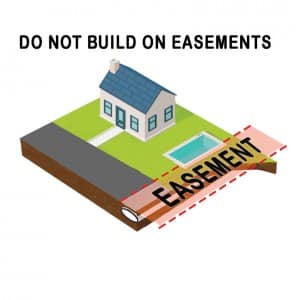Avoid Easement Woes
Perhaps you share a driveway or access road with your neighbor, or you have a section of land that you share with others, or you have heard the words “utility easement.” Do you know your rights when an easement issue on your property rears its ugly head and, for example, the cable company wants to dig on what you thought was your private property? Let’s explore what easements are, the situations that could result in conflict, and how to deal with them.
What is an easement?
An easement is a part of a property in which there is shared access. An easement dictates what rights you have and what entity owns the right of way. Easements are generally created when a subdivision is developed and its plat is recorded with the County Clerk’s office. The easements provide access for gas, power lines, telephone lines, water and sewer pipes, cable TV, and other public utility needs. There are three primary kinds of easements:
Right-of-Way Through Property:
In this case, you would either grant or be granted permission to cross through someone’s property to gain access to your own property (or allow someone to cross through yours to get to theirs). This could include long private roads through which someone might have to drive to access a property at the back. Issues in this case could stem from an owner not maintaining the access.
• • •
Right-of-Way Grant:
This would refer to shared properties such as driveways or walkways. The issues in this case could include who is responsible for maintaining it (i.e. shoveling debris or fixing cracked concrete).
• • •
Utility Easements:
Here’s one that trips up many homeowners. In this case, the actual utility (gas, electric, telephone, cable) access for one property is on another property. It could be wires, poles, boxes, etc. This is where the situation can get thorny in two ways. First, fences and barricades must allow access for maintenance or repair crews to enter the area. Homeowners often fail to understand this before they install barriers such as fences, or, worst-case scenarios: outbuildings or a swimming pool. This can lead to fines or the costly need to tear down those fences or buildings, or remove the pool. Second, if digging is required on one property to access a line connected to a neighboring property, there is often the question of who pays to fix the mess created. Do you as the homeowner or does the city or utility company? Understanding your rights in these cases is important.
• • •
How to handle easement issues?
So what do you do when you’re faced with a conflict arising from an easement issue?
#1
When you purchase your home, ask if there are any easement-related issues about which you should know and rights and obligations you have. Make sure you check the survey to see if there are easement lines on your property. If you are building your home, the builder should have the survey and building plans with any easement restrictions attached. Make sure to ask your builder to give you a copy, and then keep it in a safe place for as long as you own the home. You never know when you may need it!
• • •
#2
If you already own your home, you may still wish to check with the County Clerk’s office to confirm what is required of you, especially before beginning any new construction projects, or even building a fence if your property line is on an easement. Your local Planning and Zoning office should have the information you need.
• • •
#3
The biggest lesson: Don’t get caught with an easement barrier that ends up costing you big! Always consult with the County Clerk’s office before building or remodeling if you don’t know what your easement requirements are. You can also call your utility company for clarification of the easement areas on your property.
• • •






